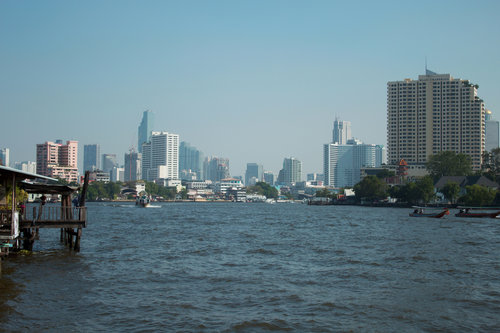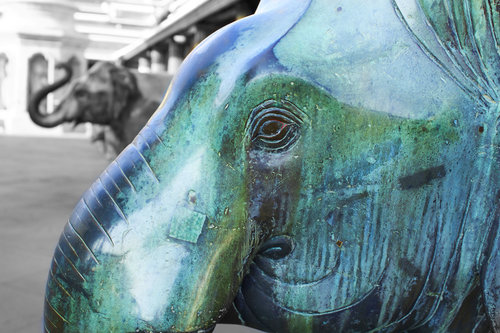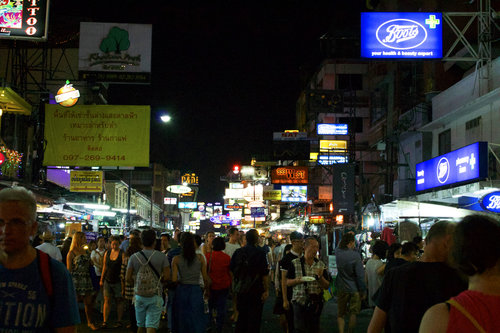While barreling down an expressway one evening in a bus with Sarah and Colum, my two companions at the time, I took a break from listening to the beautiful slurred verses of Young Thug and at some point decided to look out of my window. Christ, what a mess! I'm not ashamed to report that fear was among the manifold feelings that the sight of the city stirred within me, sitting awash in its urban glow. The skyline seemed erratic and difficult to make sense of and many buildings were adorned with black banners in homage to the late king, Bhumipol Adulyadej. Skyscrapers loomed as far as the eye could see on either side of the bus and I was glad to find that I wasn't the only one feeling lost and overwhelmed in the visual overload of the great Thai capital; Sarah and Colum were glued to their windows as well. Colum, hailing from New York City, was used to sights like these but seemed impressed nonetheless. Sarah and I, on the other hand, confided to each other that it might simply be too big for us to live there comfortably. Similar to Los Angeles in terms of the endless sprawl surrounding the city center (it's bigger than LA) and resembling aspects of New York, in that from certain vantage points skyscrapers seem to dot the distance eternally (it's smaller than New York) this was without a doubt the largest city that I had ever had the good luck to interact with, and still is at the time of this writing.
Bangkok seems especially gigantic when considering the average size of other cities in Thailand. It's considered a "primate city" which basically means that it's so much bigger than any other city in the country such that everywhere outside of the city depends on it for cultural, economic, political, and major transportation needs. Think London, Dublin, Kuala Lumpur, Mexico City, and Seoul. Bangkok, however, has been referred to as the most primate city on earth because it is a whopping thirty five times as large as the second largest city in Thailand. I can affirm that when conversing with Thai people in the times that I have ventured outside of it, The Big Mango is certainly viewed as an exceptional case that operates by its own set of standards. Consider the following conversation I had with the owner of a guest house in Chiang Rai:
Guest house owner: So, you like to ride a motorbike around Thailand?
Yours Truly: Yeah, it's great! I was extremely nervous at first, but I'm used to it now.
Guest House Owner: Yes, Thailand is a very easy place to travel around by motorbike.
Yours Truly: Except for Bangkok, of course.
Guest House Owner: Oh, Bangkok? That's another story completely! You can't drive there, you'll get killed!
In every part of the country I've visited outside of it, people seem to regard Bangkok in a similar fashion. When I was in the process of gathering useful advice and information before I had even left Montana, one person that had spent a decent amount of time in Thailand told me to stay out of Bangkok altogether. However, now that I've been here for a decent amount of time, that seems virtually impossible. If not impossible, then certainly inconvenient. When talking with Thai people on the islands and in Pattaya, it always entered the conversation as something gargantuan and unavoidable. It was interesting hearing the urban mammoth mentioned with such frequency during this time, knowing full well that it was where I would likely end up living. By the time the three of us arrived, it sort of felt like the object of a quest that I had been participating in more or less unwittingly since I got off the plane in Phnom Penh.
I have reached a point in this entry where, if I wish to continue relating my story, it is necessary for me to discuss the late king of Thailand, Bhumipol Adulyadej, also referred to as Rama IX. His passing in October of 2016 threw the country into disarray, and kickstarted an austere period of mourning, which, by the time of this writing, is still in full swing. Rama IX ruled over Thailand from 1946 until the time of his death, making him the worlds longest serving head of state, and more importantly, the only monarch that most Thai people have ever been ruled by. Universally beloved here and abroad, his long reign acted as the glue of Thai society, as Thailand endured many divisive crises and coups throughout the twentieth and twenty first centuries. His conduct as a head of state was impressive and applaudable, as was his personal life; he was a renaissance man by almost any measure. Involved personally in many social and economic developments across Thailand, the King was also a proficient painter, musician, author, translator, and photographer. He designed sailboats, considered himself a radio amateur, and invented a waste water aerator, which basically makes him an inventor and engineer. His musical career is particularly noteworthy: he was an accomplished saxophone player, composed jazz ballads, and performed with the likes of Stan Getz and Benny Goodman. Becoming an expert in any one of these fields over the span of a lifetime is a notable achievement for any human being, but to become an expert in all of them while simultaneously acting as the head of state is nothing short of Herculean.
Before arriving to the city, we had reserved a large private room in the Phra Kanong area in a hostel called “Pridi,” where we ended up staying for the remainder of the three and a half weeks that the three of us stuck together job hunting and enjoying the quirks of life in this massive clusterfuck of a city. We considered moving around to other areas of the city but once we settled in, we realized how good of a deal we were getting price-wise and considering it's central location, reasoned that it would be irresponsible to try our luck somewhere else (although calling anything in this mess “central” is something of a bad joke). There was an abundance of places to eat at most hours of the day, which is something I've found true about this city as a whole. It's absolutely teeming with food, and it's some of the best that I've ever savored in the quarter century that I've been roaming around this shithouse of a globe. In recent days I've developed a struggle with weight gain because it feels like an absolute tragedy when meals end. Public transportation was located nearby as well, which is a topic that deserves an entry of its own. The skytrain and subways here are efficient, clean, and cheap which, according to New York City yokel, Colum, is more than some places in the US can claim.
After settling into our hostel, We deigned that it was high time to do some proper touristing. We headed to the Chao Praya river, the course of which almost the entire center of the city was constructed around, to get a glimpse of some of the oldest parts of the city. Snaking along it's path until just south of the city it reaches the sea, intersected by manmade canals called Khlongs, it would be no understatement to call the Chao Praya a veritable backbone of the city and the very source around which the rest of old Bangkok was built. The pier abreast the run of the river was absolute chaos. We took tickets, not exactly sure what they were for, but determined to follow other people if they happened to rush onto one of the boats that docked every thirty seconds or so. Old tires lined the length of the dock and I had no idea what for until I saw the first of the boats approaching. At full speed. Before anyone could issue a word of warning, the boat slammed into the dock and the jellylike legs of impatient caucasian tourists shook like mad, as did the dock upon which they stood. Finally, as we were ushered into the relative safety of a boat after another wild crash twixt its body and the layer of old tires, we sailed across the Chao Praya for Wat Arun.
A Buddhist temple has existed at the site of Wat Arun since around the 1400's, however, the construction of the building erected there currently ended in 1656 at the latest, according to French maps of the region assembled in that year. One of the main tourist attractions in Bangkok, and able to be seen from the naked eye from many vantage points among the area around the Chao Praya river, Wat Arun is an impossible landmark to miss for people visiting the strange marriage of present and past that is to be found in the older sections of Bangkok. Here, the ends of many canals which snake around the city, known as khlongs, can be found, as can conglomerations of simple river houses comprised of very basic building materials and situated on stilts which pockmark the entire river area. Nearby, and in some case connected to these constructions, are shopping malls and nicer restaurants including modern comforts like air conditioning, name brands, and smoke free areas. Seeing these two kinds of establishments acting as neighbors makes for a striking contrast indeed. The three of us had a wonderful time exploring the visual buffet of Wat Arun, whose name literally translates to “Temple of Dawn,” in English. However, even though there was plenty of eye candy to behold, the main temple had been under construction for a couple of years and remained so during the time of our visit (at the time of this writing, renovations have been completed and Wat Arun sparkles in the morning light once more, and continues to illuminate the Siamese nights, warding off all that would bestow ill fortune upon the capital city) thus, many pictures that we took couldn't help but include the unsightly scaffolding which adorned the main shoot of the temple. Still, scaffolding and all, the experience was certainly worth the money that we paid, to say nothing of the confusing journey across the river that we undertook. Another temple that is not to be missed here is Wat Pho. According to tourist guides and the internet, it's the oldest temple in Bangkok, as it was constructed before the city even became the capital of Thailand. It currently houses the largest collection of buddha images in Thailand, culminating in a giant reclining buddha statue 150 feet long adorned in gold leaf. It's also considered one of the first public education centers in the country. Your dear author got lost more than once trying to find his way out of the gigantic complex.
Shambling our way through a central quarter of Old Bangkok after visiting Wat Arun, we came across swaths of people dressed in black from head to toe, waves of which were being shepherded by the Thai police. We had unknowingly stumbled upon the funeral procession for the late king. Although we expected to come across mourners, seeing as the whole of the country was more or less distraught, the sheer number of these mourners was out of this world. There were giant volunteer kitchens serving food to the bereaved and we thought we had seen the last of the grieving populace when we saw further waves of mourners being corralled by the aforementioned police in well managed sections, many blocks away. It seemed to never end, it must have been the largest conglomeration of people that I've ever seen in one area. Some of them were grieving visibly, breaking down in single file line and wiping away tears as the sun set over the capital. I can't estimate how many mourners were waiting patiently to pay respects to their King, but it was certainly in the thousands. Many thousands. I couldn't help but to make comparisons to my native home of the USA, which had just elected a jackass to its highest office, who need not be named here. To think of how US presidents get treated, even as they exit this world, is absolutely astounding in comparison to the respect that I have seen ushered forth by the Thai people upon the passing of their head of state. Such love for a political ruler seemed utterly alien to me (although the Obama years will surely be missed); we simply don't have the kind of veneration for the head of state that the Thai people do as a cultural matter of fact. Besides Angkor Wat and The Killing Fields, it remains one of the most vivid impressions that I've ever received since being in this part of the world.
In another stretch of the Old Bangkok, there is a particular street that comes alive; where foreigners of all shapes, sizes, colors, creeds, and castes howl in drunken ecstasy every night. Every morning, the ground offers up a foul smorgasbord of gifts to greet the new day: carelessly poured beer, cigarette butts, deflated balloons, and empty cartridges of laughing gas along. This sinful street goes by the name of Khao San Road and it's certainly a far cry from the profound solemnity evoked by the dazzling temples nearby. The three of us made our way there during New Years eve because there was supposed to be a magnificent firework show around the grand palace, located nearby, but during this particular year, however, a reduction in all celebrations has been required as a result of the late King's passing. Still, as one can see from the photos provided, festivities were observed with or without fireworks, and towards the latter part of the evening we made our way towards Nana Plaza, a red light district, with some new found “friends.” Nana turned out to be nothing short of a collection of stripper clubs, and Sarah left early, disgusted by what she had seen over the course of this night of the new year. Colum and I ended the night at a Mcdonalds, delivering a lecture to some Europeans on the relative superiority of the second amendment. Joy, indeed!
Besides playing the part expected of a tourist, I spent most of my first three or four weeks in Bangkok going for extended walks, yoyoing up and down the BTS skytrain, drinking to excess, and looking for work. Having no teaching experience and knowing that an absolute myriad of jobs were available to the average native English speaker with a teaching certificate, ranging from the utter hell of working in a government school to the relative ease of international language schools, I tried to go into the search for gainful employment with as open of a heart and mind as was possible for my particular constitution. We arrived at a time of the school year where positions, while not exactly scarce, aren't as easy to obtain. I eventually landed an interview with a company called Wall Street English, and while initially laughing myself to death over the name, found myself preparing for a series of interviews, and then for a period of training after accepting a job offer, for a gig which, at the time of this writing, has blessed me with some of the most rewarding experiences that I've ever had among my quarter century crawl about this cursed blue rock of a planet. Until then, Waste well and eat something divine.
To read more of Dan's adventures abroad, click here!


















